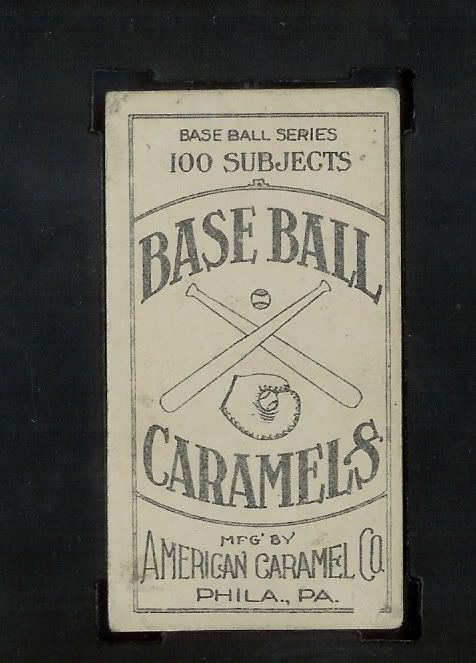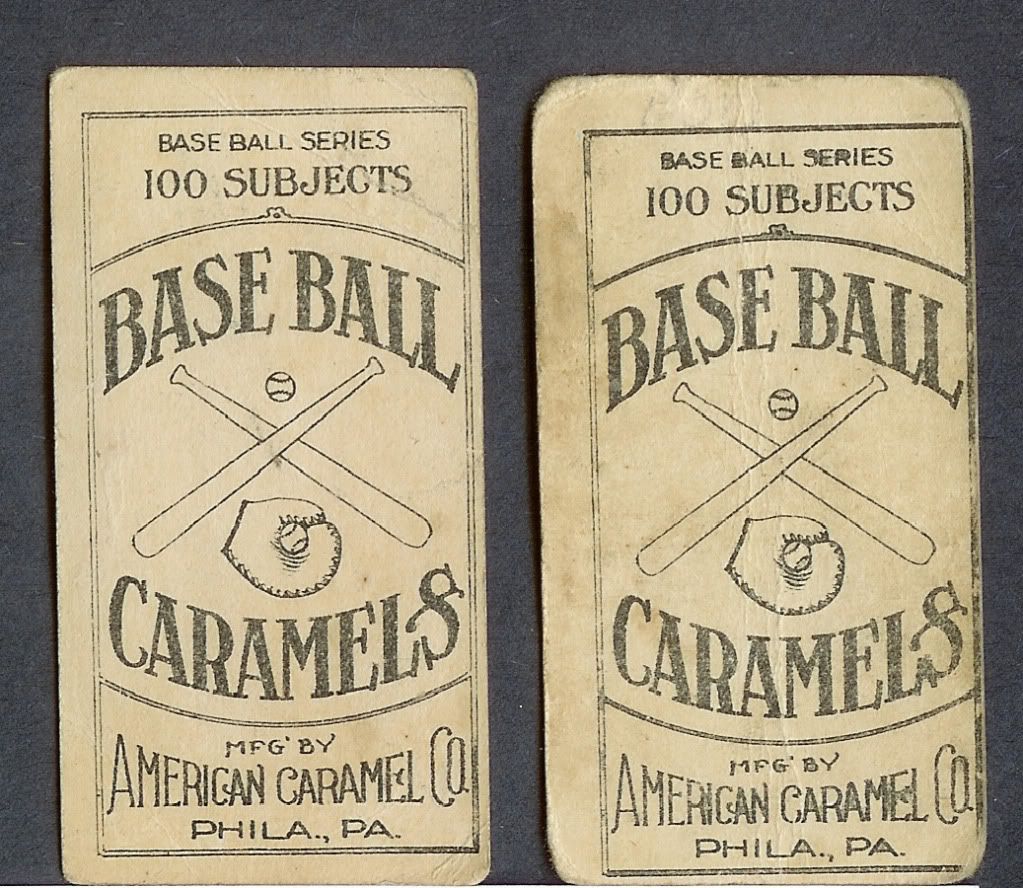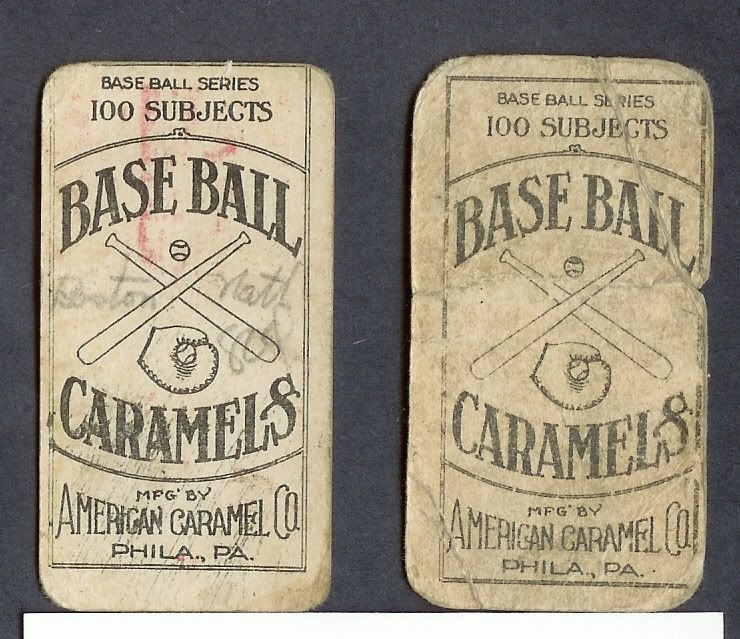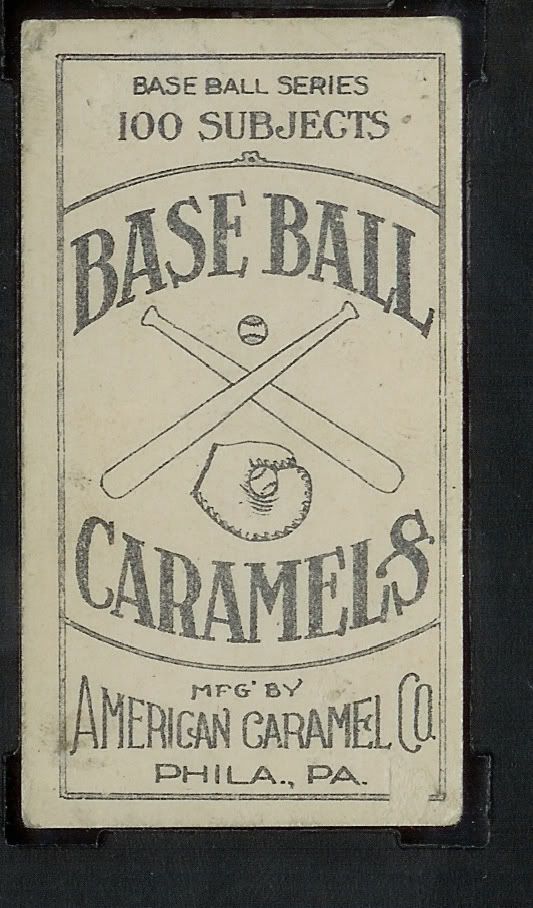|
|
#1
|
||||
|
||||
|
I've been corresponding with a New York collector who is seeking recognition for what he has identified as "shaded-back" variations on (so far) nine different E90-1 cards.
The picture here shows (in red) the areas on which a gray shading has been found on these potential variations. I'm here to ask you to check your E90-1 backs for such shading. I don't want to name the cards that have been so far identified, so as not to taint the results. At this point I don't know if this is a legitimate variation, a printing anomaly or a kid with a #2 lead pencil. If more than one example of the shaded back can be found for one or more of the currently known players, we may have a true variation to consider. Please post 'em if you've got 'em, or send me a PM or e-mail. Thanks much! E90-1 back shaded.jpg
__________________
My (usually) vintage baseball/football card blog: http://boblemke.blogspot.com Link to my custom cards gallery: http://tinyurl.com/customcards |
|
#2
|
|||
|
|||
|
Bob, I've seen what you are describing on many different E90-1's over the years. My own opinion is that the effect is due to either over inking or wearing down of the printing plates. Regards, Paul
|
|
#3
|
||||
|
||||
|
Quote:
then it would occur in any card, randomly, with equal probability.... when you only find it on specific player cards, it is not random... true, a different printing plate was used, signifying a separate print run... |
|
#4
|
||||
|
||||
|
wow , just realized Bob posted this yesterday morning.....
crickets.................. |
|
#5
|
||||
|
||||
|
I just looked at all of mine (25 different), and they are all unshaded.
Steve |
|
#6
|
||||
|
||||
|
I think to confirm their status as true variations, we need to see more than one "shaded" example for one or more of those that are now known.
I know that would be easier with a more commonly encountered set, but surely there are enough E90-1s out there to confirm or disprove this theory.
__________________
My (usually) vintage baseball/football card blog: http://boblemke.blogspot.com Link to my custom cards gallery: http://tinyurl.com/customcards |
|
#7
|
||||
|
||||
|
Bob,
I'll try to check my cards when I get home this evening. Rob |
|
#8
|
|||
|
|||
|
Hi Bob,
I have 3 HOFers: Young (Boston), Crawford, and Eddie Collins...none shaded. Cheers, Blair
__________________
My Collection (in progress) at: http://www.collectorfocus.com/collection/BosoxBlair |
|
#9
|
||||
|
||||
|
Bob- For what it is worth, I went through my entire E90-1 set today and didn't find a single gray shaded back. These cards were purchased card by card on ebay about 10 years from many, many different sellers.
tbob |
|
#10
|
|||
|
|||
|
I checked the few I have, and There were none in about 15 cards.
Steve |
|
#11
|
||||
|
||||
|
Quote:
I'm with Paul on this one. I sold my set months ago, and put it together piece by piece just as TBob did and probably had a dozen or so with the shaded area as mentioned. It always looked like loss of ink to me more than a variation. |
|
#12
|
||||
|
||||
|
look at the baseball in the middle...no ink loss there, and it is clearly different from the normal.....notice how that SHADED areas are always INSIDE the lines and NEVER cross over the lines (which would be indicative of a printing "error" or smudging)

Last edited by ScottFandango; 02-17-2010 at 06:23 PM. Reason: spelling |
|
#13
|
||||
|
||||
|
any luck looking at those E90-1 Backs?
|
|
#14
|
|||
|
|||
|
Scott - what player is that? It will help with Bob's survey. Also, that's a bit different then what Bob showed above , with several letters bieng partially or completely filled in.
Last edited by Matt; 02-18-2010 at 07:04 AM. |
|
#15
|
||||
|
||||
|
Cant say who that is...yet
true, some of the "B's" are shaded in also...that is less noticeable though... the baseball shows it the best |
|
#16
|
||||
|
||||
|
more scans please
Last edited by ScottFandango; 05-15-2011 at 06:01 AM. |
|
#17
|
||||
|
||||
|
Will check what I have and get back tomorrow.
Brian |
|
#18
|
||||
|
||||
|
I don't know how "big of a deal" this appears...I am an advanced type collector with a bunch of e90-1's...but don't see this as anything groundbreaking. Certainly not as groundbreaking as the ultra rare e94 single/double quotation variation on its backside?
|
|
#19
|
||||
|
||||
|
I would like to see one up close.... but my first guess is that this is nothing more than a print defect and not a purposeful variation.
__________________
Joe D. |
|
#20
|
||||
|
||||
|
Joe, wouldnt a Print defect be random? meaning it could happen to ANY card in the set?
how about this.....for a specific print run of the E90-1 series (which we know there are several), they used an older (or different) printing plate to make the reverse...the resulting cards ALL looked a bit different than the first few series backs...is this a print defect? dont think so Peter, do you have any of these backs? Last edited by ScottFandango; 02-18-2010 at 10:07 AM. Reason: spelling |
|
#21
|
||||
|
||||
|
Quote:
no, a print defect wouldn't have to be random. print spots are print defects - - and they pretty much stick to the same spot on the same card(s). I'm not saying this is a print spot at all.... just giving an example of how a print defect is not random. most certainly during the printing process you can have a specific problem (a defect) on a specific area of the sheet (or on the whole sheet) / that eventually gets attended to. on to your point about using different plates. I would suspect MOST EVERY pre-war card went on press with different plates (edit: meaning more than one press run for each card). A printing plate only has so much usefulness in it. One could only guess how many different plates (of the same card) were used for the e90-1, or the T206 or for say Topps cards. A different press run / and a different physical plate does not make it a purposeful variation. A purposeful variation would come in the pre-press if someone change the artwork that was used for the plates. Basically what I am saying from the scan (not seeing it in person) - it looks nothing more than a print defect and does not look like an artwork change. I could be wrong. I've been wrong before and will be wrong many many times again.
__________________
Joe D. Last edited by bijoem; 02-18-2010 at 10:30 AM. Reason: clarification |
|
#22
|
||||
|
||||
|
scott...i haven't checked yet...i will try to when i get home today.
|
|
#23
|
||||
|
||||
|
is the White Letter Mantle a print defect or a variation?
its both! many times a Print defect can be considered a variation, especially when they only appear on certain cards.... that is they key here, as Bob suggested....if ANY CARD had the shaded back, it means nothing....when only a few have it (predictably) then, there is something substantial..... |
|
#24
|
||||
|
||||
|
Quote:
I consider 'print defect' and 'variation' two distinct things. not sure how the rest of the hobby views the issue - but that is my 2 cents.
__________________
Joe D. |
|
#25
|
||||
|
||||
|
what do you consider the white letter mantle?
|
|
#26
|
||||
|
||||
|
I can honestly say - I am not familiar with the card.
Other than a brief dabble into the era many years ago (I have a 69 deckle edge set, and a 68 game set, and at one time I purchased some 52 topps commons)...Mantle is way beyond the years I collect. I don't think I purchased a card from the 50s or 60s in about 25 years or so. So - the answer is... I have no idea. But..... to me it comes down to intent..... so - if the card company intended to make a change (not just sloppy printing) - I would call it a variation.
__________________
Joe D. |
|
#27
|
|||
|
|||
|
Mantle was not the only white letter variation in 1969, there were numerous players whose previously yellow names appeared white. Were all these players part of the same sheet? If so, it may just be an inking error. If they appeared in different series, then it was probably a deliberate variation. Unfortunately, I don't remember which players have the white letter variation.
|
|
#28
|
||||
|
||||
|
Quote:
Barry - if there is yellow still on the card somewhere else.... it would indicate an intentional change and not an inking problem. basically if the yellow is truly missing from the card - it would be missing everywhere not just in one spot (like Jeff's White Chase). Again... not knowing the card - if there is yellow on the card somewhere else, I would call the 'white letter' a variation. The e90-1 difference shown in this thread most definitely could be achieved through bad printing / print defect. Taking yellow out of a name but leaving it everywhere else would have to happen with some intent or active effort on someone's part.
__________________
Joe D. |
|
#29
|
|||
|
|||
|
Joe- absolutely correct, and that is what I was trying to figure out. That's why I asked whether all the white variations were on the same sheet. Then again, all 132 cards would have to be white, and they aren't.
|
|
#30
|
||||
|
||||
|
the name is not important...
if there is a difference in the back, there is a difference in the back... when only certain players have the "difference", it needs to be noted ... especially it needs to be noted by TPG's labels... Last edited by ScottFandango; 02-18-2010 at 03:19 PM. Reason: spelling |
|
#31
|
||||
|
||||
|
Scott,
I'm one of the slower and denser members of this board, but I have taken away four truisms during my time here. For the record: 1. I never argue with Jeff Lichtman in matters of criminal defense. 2. I never argue with Barry Sloate in matters of spelling and grammar. 3. I never argue with Joe D. in technical matters concerning printing. 4. I always argue with Bruce Dorskind (Magna Cum Laude), on everything. |
|
#32
|
||||
|
||||
|
what college did bruce go to>?
|
|
#33
|
||||
|
||||
|
I dunno what college he went to *(Yale or Ivy or something) but I do know he doesn't like some guy that goes by the name "Archive".
__________________
Leon Luckey www.luckeycards.com |
|
#34
|
|||
|
|||
|
Vassar?
|
|
#35
|
|||
|
|||
|
Scott- I think he went to all the Ivy League colleges...and at the same time! Not easy to do, since they are located in different cities.
And I saw that "semantics" but didn't want to bug you about it. 
|
|
#36
|
||||
|
||||
|
thanks, my wife wasnt here to ask for proper spelling
|
|
#37
|
|||
|
|||
|
The way you spelled it was closer to "some antics."

|
|
#38
|
||||
|
||||
|
same player, 2 different backs....

|
|
#39
|
||||
|
||||
|
same beater, different backs

|
|
#40
|
|||
|
|||
|
Seeing those last two, I'd have to think Joe D is right. The shaded ones have the look of a dirty plate if they were typography for the backs, and a dry or improperly wiped stone if lithographed. The shading is right where "gunk" would collect on the plate, especially the areas of the s and e of series in the top pair. The lower pair shows the same thing in different ways on both cards.
I'm going with a wild guess, and guess that they're either all early series cards where they cut corners to get more made quickly, or last series cards where the wipers were worn, the plates dirty and they didn't bother cleaning the plate or getting a better wiper because they were almost done with the print run and knew there wouldn't be more from the same plate/stone. And I'm leaning way in the directon of the latter. Steve B |
|
#41
|
||||
|
||||
|
It looks to me that they have a random amount (depending on the card) of shading around the borders. Here are three of mine.
Rob sc0075513402.jpg sc0075513401.jpg sc00755134.jpg |
|
#42
|
||||
|
||||
|
looks like the last one (of the 3) is the only one that is a shaded variation
Last edited by ScottFandango; 02-18-2010 at 08:33 PM. Reason: clarification |
|
#43
|
||||
|
||||
|
Scott....
This is an interesting thread - - and I could sense excitement from you about these "shaded" cards.... but looking at the examples provided by you (especially your post at 7:49pm) - I am pretty confident that this is just poorly printed sheets. Looking at the White Letter Mantle on eBay.... that is a variation. It is NOT a print defect at all. It was a purposeful removal of the yellow in the name / while leaving yellow elsewhere. Personally - I wouldn't give this a new designation at all. I don't mean to quell any enthusiasm..... But to give an honest reply to Bob Lemke's original post - I don't think this is a legitimate variation.
__________________
Joe D. |
|
#44
|
||||
|
||||
|
but what if it only happened in 9 cards?
then what ? and what if the 9 cards had VERY low Pop reports (sgc and psa) compared to the rest of the set? would that tell you anything? thanks for your response |
|
#45
|
||||
|
||||
|
Quote:
|
|
#46
|
||||
|
||||
|
you would call this a poorly printed sheet?>

|
|
#47
|
||||
|
||||
|
Quote:
thanks for posting Last edited by ScottFandango; 02-18-2010 at 09:24 PM. Reason: correct |
|
#48
|
||||
|
||||
|
just out of curiosity, i went through every Ebay E90-1 listing that had a good scan of the back and i couldnt find ONE shaded version....
what happened to those who said they would check their own cards? whatever you want to call this , the fact is they dont show up often, and they predictably show up on certain cards only.... this isnt over. |
|
#49
|
||||
|
||||
|
I have 16 different cards that have varying degrees of shading. I decided to concentrate my investigation on this by strictly looking at the parallel border lines that surround the card. I have four that are near fully shaded, five that are partly shaded, and seven that are just shaded in spots.
I think the key is that there are varying degrees of shading that are out there. It was mentioned that the only one of the cards that Robert showed in a previous post was the shaded variation...however those other two cards have areas in the border where there is some shading. I think this spotty nature in the amount of shading dovetails nicely with the idea mentioned earlier about gunk not being cleaned out from the plates...Iggy the hunchback was always getting delayed with sweeping the larvae and dead insects from the printroom floor and neglected to clean off the plates, so runs of cards became progressively 'shaded'. So it is my belief that it is just a lack of quality control, just like cards that are seen with bad registration. Just to throw out the cards with this 'issue' that I have: Lots of border shading Phelps Overall Miller Fromme Cards with more than half border shading Marquard Groom Gray Demmitt Camnitz Cards with just 'spot' of border shading G.Davis Davis Leach Keeler Pink Brown Bransfield Pink Willis Brian Last edited by brianp-beme; 02-19-2010 at 08:55 AM. Reason: added band name in the title |
|
#50
|
|||
|
|||
|
To me this is just a little extra black ink bleeding into the design.
Look at Scott's example in post #46. Many of the letters, both at the top and bottom, have some loops with shaded areas and others which remain white. Could that be a variation? Was that deliberately designed by the artist? Doesn't make sense to me. |
 |
| Tags |
| e90-1 variation |
|
|
 Similar Threads
Similar Threads
|
||||
| Thread | Thread Starter | Forum | Replies | Last Post |
| !st known 1940 Play Ball hi# Superman ad back | Archive | 1920 to 1949 Baseball cards- B/S/T | 4 | 09-27-2008 02:56 PM |
| How many T207s make a set ??? variations ??? | Archive | Net54baseball Vintage (WWII & Older) Baseball Cards & New Member Introductions | 18 | 05-09-2007 01:26 PM |
| WANTED: 1954 Bowman Back Variations | Archive | 1920 to 1949 Baseball cards- B/S/T | 0 | 12-08-2006 03:07 PM |
| Looking for 1933 WWG back variations | Archive | 1920 to 1949 Baseball cards- B/S/T | 0 | 03-12-2006 01:08 PM |
| Looking for W514's - Nice examples & Back Variations | Archive | Pre-WWII cards (E, D, M, etc..) B/S/T | 0 | 01-03-2006 01:17 PM |